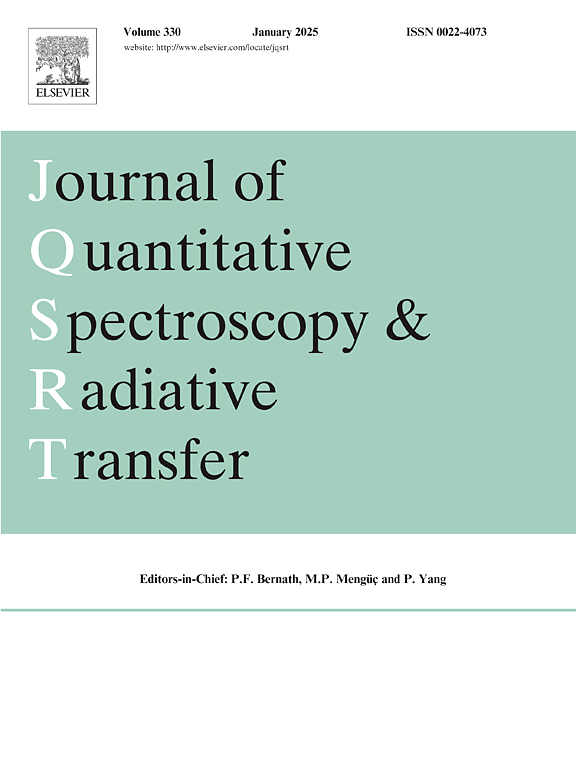Differential chirped-pulse dual-comb spectroscopy for complex line shape fitting the R(6) manifold of the 2ν3 band of methane
IF 2.3
3区 物理与天体物理
Q2 OPTICS
Journal of Quantitative Spectroscopy & Radiative Transfer
Pub Date : 2025-03-25
DOI:10.1016/j.jqsrt.2025.109454
引用次数: 0
Abstract
We use a dual electro-optic comb system (EO![]() OFC) and a differential chirped-pulse down conversion technique to study the R(6) manifold of the 2ν3 band (1645 nm) of methane at low pressure (< 1 kPa). In the frequency domain, the EO
OFC) and a differential chirped-pulse down conversion technique to study the R(6) manifold of the 2ν3 band (1645 nm) of methane at low pressure (< 1 kPa). In the frequency domain, the EO![]() OFC method magnifies of the temporal dynamics of the system and due to of the 6-component asymmetric line shape, is shown to give unique amplitude and phase spectra that depend on the chirp direction. We model the frequency domain complex response function using chirped-pulse multiplication and convolution with the Kramers-Kronig transfer function of the molecular system. We then compare how the predicted Voigt line shape with parameters from HITRAN2012 and HITRAN2020 databases and the Hartmann-Tran profile (HTP) perform for fitting both the temporally magnified magnitude and phase profiles in the frequency domain and following the removal of these effects from back transformation, the traditional (natural) line shape components in the time domain. The complex responses in the two domains give unique insight into the physical nature of time dependent absorption processes that may help guide development of molecular models to improve their predictive behavior of both amplitude and phase.
OFC method magnifies of the temporal dynamics of the system and due to of the 6-component asymmetric line shape, is shown to give unique amplitude and phase spectra that depend on the chirp direction. We model the frequency domain complex response function using chirped-pulse multiplication and convolution with the Kramers-Kronig transfer function of the molecular system. We then compare how the predicted Voigt line shape with parameters from HITRAN2012 and HITRAN2020 databases and the Hartmann-Tran profile (HTP) perform for fitting both the temporally magnified magnitude and phase profiles in the frequency domain and following the removal of these effects from back transformation, the traditional (natural) line shape components in the time domain. The complex responses in the two domains give unique insight into the physical nature of time dependent absorption processes that may help guide development of molecular models to improve their predictive behavior of both amplitude and phase.
甲烷2ν3波段R(6)流形拟合复杂线形的差分啁啾脉冲双梳光谱
我们使用双电光梳系统(EOOFC)和差分啁啾脉冲下转换技术研究了甲烷在低压(<;1 kPa)。在频域,EOOFC方法放大了系统的时间动态,并且由于6分量的不对称线形,显示出依赖于啁啾方向的独特幅度和相位谱。我们使用啁啾脉冲乘法和卷积与分子系统的Kramers-Kronig传递函数建立频域复响应函数模型。然后,我们将预测的Voigt线形与HITRAN2012和HITRAN2020数据库中的参数以及Hartmann-Tran剖面(HTP)进行比较,以拟合频域的时间放大幅度和相位剖面,并在从反向变换中去除这些影响后,在时域中去除传统(自然)线形分量。这两个领域的复杂响应提供了对时间依赖吸收过程的物理性质的独特见解,这可能有助于指导分子模型的发展,以改善其振幅和相位的预测行为。
本文章由计算机程序翻译,如有差异,请以英文原文为准。
求助全文
约1分钟内获得全文
求助全文
来源期刊
CiteScore
5.30
自引率
21.70%
发文量
273
审稿时长
58 days
期刊介绍:
Papers with the following subject areas are suitable for publication in the Journal of Quantitative Spectroscopy and Radiative Transfer:
- Theoretical and experimental aspects of the spectra of atoms, molecules, ions, and plasmas.
- Spectral lineshape studies including models and computational algorithms.
- Atmospheric spectroscopy.
- Theoretical and experimental aspects of light scattering.
- Application of light scattering in particle characterization and remote sensing.
- Application of light scattering in biological sciences and medicine.
- Radiative transfer in absorbing, emitting, and scattering media.
- Radiative transfer in stochastic media.

 求助内容:
求助内容: 应助结果提醒方式:
应助结果提醒方式:


